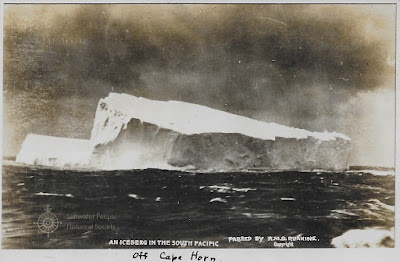 |
| EDWARD SEWALL, Seattle. 136762 322' x 45.3' x 25.5' Built in 1899, Bath, ME. Original photo from the archives of the S.P.H.S.© Donated by Skip Bold. Click to enlarge. |
 |
| STAR OF SHETLAND (ex-EDWARD SEWALL) by artist/author W.S. STEPHENSON, USN. SHIPS, A Collection of Marine Illustrations. Ben Kreis Agency, Vancouver, WA. 1947 Archived S.P.H.S. Library. |
On 10 March, the SEWALL passed through the Strait of Le Maire. Four days later she had reached a position west of Cape Horn. On the 15th she was within three miles of the beach. At this moment the wind hauled ahead. During the next five days, the vessel made a course almost due south, arriving on the 19th at a point 68 W., 60.20 S., or about 300 miles south of her position on the 14th.
During the next three days, a number of tacks were made, resulting in a net loss of westing. Between 22 and 26 March, the vessel made about 300 miles of westing and reached a point 79.09 W., 60.40 S. This was the farthest south made during the struggle to weather the Cape.
 |
| Off Cape Horn |
During the next three days (16-19 April) the vessel made about 250 miles of westing. Between 19 April and 4 May, many tacks were made. At one time (26 April) the SEWALL reached a point 76.57 W., which longitude had been reached a month previously. She was driven back, and on 4 May had arrived at the longitude of 71.47 W.
The latter date marks the turning of the corner, the end of a fight which had lasted without intermission for two months. Between 4 and 6 May the SEWALL made a course nearly due west. At midnight on the 6th, she crossed the meridian of 76 W., which position she had previously reached on two occasions (28 Mar and 26 April.) From this time the course lay north and west. On 8-9 May the position was about 79 W., 55 S. Cape Horn had been weathered. The hard-fought battle had been won.
 |
| Courses made by American Ship EDWARD SEWALL (1914) From Last Days of Sail on the West Coast, Walter MacArthur. (1929) |
The full period occupied in making the passage from 55 S. in the Atlantic to 55 S. in the Pacific (10 Mar-8 May) was 59 days. Estimating the net distance in westing at 15 degrees (or 500 miles), the average gain was about eight miles a day. During the entire period, the ship traversed fifty-four courses and crossed her own tracks twenty-five times. The distance sailed on the numerous courses aggregated 3,564 miles. During the entire passage from Philadelphia to Seattle, the SEWALL traversed a distance of 23,407 miles. Excluding the time occupied in returning to Bahia Blanca and making repairs, the actual sailing time was 216 days.
|
Then follows many ship log notes...
The EDWARD SEWALL loaded at Seattle for Dublin and made the eastward passage by way of Cape Horn. Between 1915 and 1920 she made several voyages to S. American ports and to the Orient with case-oil under the ownership of the Texas Oil Co. In 1922, while lying at New Orleans, she was bought by the Alaska Packers Assoc; her name was changed to STAR OF SHETLAND. She made the passage to San Francisco by way of the Panama Canal and was then employed in the AK salmon fisheries."
Above text from; Last Days of Sail on the West Coast. MacArthur, Walter.
Press of The James H. Barry Co. San Francisco. (1929)
This ship made numerous calls in Puget Sound and Alaskan waters during her active career.
Wilfred S. Stephenson was born in Vancouver, BC, in 1912. Later a Washington artist, who formerly did commercial drawings for a Vancouver, WA printing firm. He joined the Navy where he had leisure hours at sea and mailed drawings in one at a time. The pen sketches and wash drawings gathered together by his former employer, Ben Kreis, were reproduced in the book mentioned. Especially noteworthy are the nine old sailing ships of the Alaska Packers fleet.
During the war, Stephenson was stationed at Bremerton and Friday Harbor, later being attached to the Asiatic Fleet, stationed in China and the Philippines. He visited nearly every port in the Orient, from Japan and Russia to India. During WW II he was promoted from enlisted status to that of a commissioned officer.
|





Capt Rechard quick was my great uncle
ReplyDelete